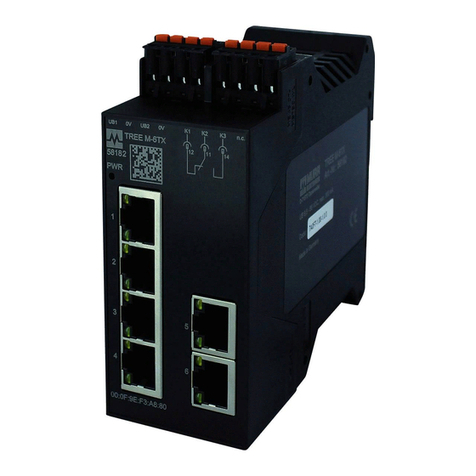
2
Betriebsanleitung
Sicherheitsrelais
MIRO SAFE+ Switch H L 24
Artikel-Nr. 3000-33113-3020012
DE
1.6 Warnung vor Fehlgebrauch
Bei nicht sachgerechter oder nicht bestimmungsgemäßer
Verwendung oder Manipulationen können durch den Einsatz
des Sicherheitsrelais Gefahren für Personen oder Schäden
an Maschinen- bzw. Anlagenteilen nicht ausgeschlossen wer-
den. Bitte beachten Sie auch die diesbezüg lichen Hinweise
der Norm EN 1088 und EN ISO 13850.
1.7 Haftungsausschluss
Für Schäden und Betriebsstörungen, die durch Montagefehler oder
Nichtbeachtung dieser Betriebsanleitung entstehen, wird keine Haftung
übernommen. Für Schäden, die aus der Verwendung von nicht durch
den Hersteller freigegebenen Ersatz- oder Zubehörteilen resultieren, ist
jede weitere Haftung des Herstellers ausgeschlossen.
Jegliche eigenmächtige Reparaturen, Umbauten und Veränderungen
sind aus Sicherheitsgründen nicht gestattet und schließen eine Haftung
des Herstellers für daraus resultierende Schäden aus.
Der Baustein ist nur im geschlossenen Gehäuse, d.h. mit montiertem
Frontdeckel zu betreiben.
2. Produktbeschreibung
2.1 Typschlüssel
Diese Betriebsanleitung ist gültig für folgende Typen:
MIRO SAFE+ Switch H L 24
Artikel-Nr. 3000-33113-3020012
Nur bei ordnungsgemäßer Ausführung der in dieser Betriebs-
anleitung beschriebenen Umbauten bleibt die Sicherheits-
funktion und damit die Konformität zur Maschinenrichtlinie
erhalten.
2.2 Sonderausführungen
Für Sonderausführungen, die nicht im Typschlüssel unter 2.1 aufgeführt
sind, gelten die vor- und nachgenannten Angaben sinngemäß, soweit
diese mit der serienmäßigen Ausführung übereinstimmen.
2.3 Bestimmung und Gebrauch
Die Sicherheitsrelais, zum Einsatz in Sicherheitsstromkreisen, sind für
den Einbau in Schaltschränken vorgesehen. Sie dienen der sicheren
Auswertung der Signale von zwangsöffnenden Positionsschaltern
für Sicherheitsfunktionen an seitlich verschiebbaren, drehbaren und
abnehmbaren Schutzeinrichtungen sowie NOT-HALT-Befehlsgeräten,
Sicherheitsmagnetschaltern und AOPD’s.
Die Sicherheitsfunktion ist definiert als das Öffnen der Freigaben
13-14, 23-24 und 33-34 beim Öffnen der Eingänge S11-S12 und/oder
S21-S22. Die sicherheitsrelevanten Strompfade mit den Ausgangskon-
takten 13-14, 23-24 und 33-34 erfüllen unter Berücksichtigung einer
PFH-Wert-Betrachtung folgende Anforderungen (siehe auch Kap. 2.5
"Sicherheitsbetrachtung"):
– Kategorie 4 – PL e gemäß DIN EN ISO 13849-1
– entspricht SIL 3 gemäß DIN EN 61508-2
– entspricht SILCL 3 gemäß DIN EN 62061
Um den Performance Level (PL) gemäß DIN EN ISO 13849-1 der
gesamten Sicherheitsfunktion (z.B. Sensor, Logik, Aktor) zu bestimmen,
ist eine Betrachtung aller relevanten Komponenten erforderlich.
2.4 Technische Daten
Allgemeine Daten
Vorschriften: IEC/EN 60204-1, EN 60947-5-1;
EN ISO 13849-1, IEC 61508
Klimabeanspruchung: EN 60068-2-78
Befestigung: Schnellbefestigung für Normschiene
nach DIN EN 60715
Anschlussbezeichnung: EN 60947-1
Werkstoff des Gehäuses: Kunststoff, glasfaserverstärkter
Thermoplast, belüftet
Werkstoff der Kontakte: AgSnO, selbstreinigend,
zwangsgeführt
Gewicht: 240 g
Startbedingungen: Automatik oder
Start-Taster (überwacht)
Rückführkreis vorhanden (J/N): Ja
Anzugsverzögerung mit automatischen Start: typ. 100 ms
Anzugsverzögerung mit Reset-Taster: typ. 15 ms
Abfallverzögerung bei NOT-HALT: typ. 25 ms / max. 32 ms
Abfallverzögerung bei Netzausfall: typ. 100 ms
Überbrückung bei Spannungseinbrüchen: typ. 80 ms
Mechanische Daten
Anschlussausführung: steckbare Federkraftklemmen
Anschlussquerschnitte: 0,25 … 2,5 mm²
Anschlussleitung: starr oder flexibel
Abnehmbare Klemmen vorhanden (J/N): Ja
Mechanische Lebensdauer: 10 Millionen Schaltspiele
Elektrische Lebensdauer: Derating-Kurve auf Anfrage
Schockfestigkeit: 10 g / 11 ms
Schwingungsfestigkeit nach EN 60068-2-6: 10 … 55 Hz,
Amplitude 0,35 mm
Umgebungsbedingungen
Umgebungstemperatur: – 25 °C … +60 °C
Lager- und Transporttemperatur: – 40 °C … +85 °C
Schutzart: Gehäuse: IP40
Klemmen: IP20
Einbauraum: IP54
Luft- und Kriechstrecken nach IEC/EN 60664-1: 4 kV/2
(Basisisolierung)
Störfestigkeit: gemäß EMV-Richtlinie
Elektrische Daten
Kontaktwiderstand im Neuzustand: max. 100 mΩ
Leistungsaufnahme: max. 2,0 W / 4,9 VA
Bemessungsbetriebsspannung Ue: 24 VDC –15% / +20%,
Restwelligkeit max. 10%,
24 VAC –15% / +10%
Frequenzbereich: 50 Hz / 60 Hz
Absicherung der Betriebsspannung: interne elektronische
Sicherung, Auslösestrom > 500 mA,
interne elektronische Sicherung,
Auslösestrom > 50 mA (S11, S21),
Rücksetzung nach Unterbrechung
der Versorgungsspannung
Strom und Spannung an: S11-S12, S21-S22: 24 VDC / 10 mA
X2: 24 VDC, Startimpuls 2,5 mA / 25 ms
X3: 24 VDC, Startimpuls 35 mA / 25 ms
Überwachte Eingänge
Querschlusserkennung (J/N): Ja
Drahtbrucherkennung (J/N): Ja
Erdschlusserkennung (J/N): Ja
Anzahl der Schließer: 0 St.
Anzahl der Öffner: 2 St.
Leitungslängen: 1.500 m mit 1,5 mm²
2.500 m mit 2,5 mm²
Leitungswiderstand: max. 40 Ω
MIRO_SAFE+_Switch_H_L_24_de.indd 2 12.06.2012 09:33:51




























